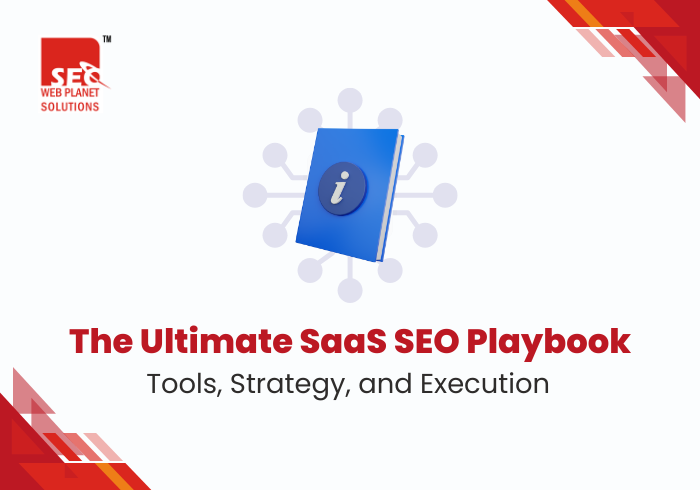The Ultimate SaaS SEO Playbook: Tools, Strategy, and Execution

For SaaS companies, organic growth doesn’t happen by chance; it’s the result of a data-driven, customer-centric SEO strategy. Unlike e-commerce or local SEO, SaaS SEO focuses on complex buying cycles, niche audiences, and products that require education as much as promotion. With rising acquisition costs and increasing competition, your organic visibility must evolve into a long-term ROI growth engine.
This playbook combines proven frameworks, Generative Engine Optimization (GEO) insights, and real-world examples to help SaaS brands build authority, attract qualified leads, and scale sustainably.
Essential SaaS SEO Toolkit
Before strategy comes structure. These tools form the foundation for every high-performing SaaS SEO Agency strategy:
- Crawlers & Auditors – Identify hidden issues, such as broken links, duplicate content, and crawl depth limitations.
- Keyword & Competitor Research – Uncover untapped opportunities and benchmark against competitors.
- Performance Testing – Evaluate Core Web Vitals, speed, and UX barriers to identify areas for improvement.
- Analytics & Heatmaps – Learn how users behave on your pages and what influences conversions.
- Content Intelligence Tools – Guide you in creating semantically rich, user-focused content.
The right mix ensures you’re not guessing, but making data-driven decisions at every stage.
How to Build a High-Converting SEO Content Strategy
Effective SEO content for SaaS companies mirrors your digital marketing funnel, speaking to prospects at every stage of their journey.
Step 1: Map the Funnel
- Awareness: Broad topics like “what is workflow automation”
- Consideration: Problem-solution pieces like “CRM to Slack integration”
- Decision: Bottom-funnel searches like “best workflow automation SaaS tool”
Step 2: Ideate Content Topics
- Use keyword data, customer questions, and competitor gaps.
- Focus on jobs-to-be-done: how your SaaS solves specific problems.
Step 3: Create Structured Briefs
- Define target keywords, subheadings, FAQs, and visuals to optimise your content.
- Map internal links to product or feature pages.
Step 4: Promote & Distribute
- Repurpose blogs into LinkedIn posts, webinars, and emails.
- Share content in communities and collaborate with partners.
Step 5: Measure & Improve
- Track rankings, traffic, CTR, and conversions.
- Refresh older posts to keep them relevant and accurate.

Case Study: Driving 300% More Organic Traffic
A B2B SaaS company offering project collaboration tools had a blog filled with generic productivity content unrelated to its solution.
Fix:
- Conducted keyword gap analysis for high-intent searches.
- Produced problem-solving guides like “How to Auto-Assign Tasks When Sales Stage Changes.”
- Strengthened internal linking to feature pages and improved site performance.
- Launched a targeted link-building campaign.
Result:
- Organic traffic grew 300% (6,000 to 24,000/month in 10 months).
- Demo requests doubled.
- Reliance on paid ads dropped by 40%.
Takeaway: When content aligns with the user’s “job-to-be-done,” SEO transforms from a channel into a conversion engine.
On-Page & Technical SEO for SaaS Websites
On-Page SEO Essentials
- Write keyword-rich titles and meta descriptions with clear CTAs.
- Use a clean header hierarchy (H1, H2, H3).
- Keep URLs short and descriptive.
- Implement internal linking between blogs, features, and product pages to enhance navigation and improve the overall user experience.
- Optimize images with compression and descriptive alt tags.
- Include structured content formats, such as FAQs and semantic variations, to enhance the user experience.
Technical SEO Priorities
- Site Speed – Optimize Core Web Vitals, caching, and CDN usage.
- Mobile Optimization – Ensure seamless layouts across devices.
- Indexing & Crawlability – Utilise XML sitemaps, canonical tags, and resolve duplicate content.
- Security – Enforce HTTPS and secure all user data.
- Structured Data – Implement schema for FAQs and rich snippets.
- JavaScript SEO – Use server-side rendering or pre-rendering for heavy JS frameworks.
Conclusion
For Enterprise SaaS companies, SEO isn’t about chasing keywords; it’s about creating scalable growth systems that align with user needs and business goals.
When executed with strategic SEO plans, continuous optimization, and GEO-based adaptability, organic traffic becomes a self-sustaining acquisition channel. Treat SEO as a long-term investment, and you’ll build compounding visibility, brand authority, and qualified leads that outlast any paid campaign.
FAQs
- How often should SaaS companies update their content?
Ans: Review high-performing pages quarterly and refresh content at least every six months to ensure ongoing relevance. Update statistics, visuals, and CTAs to ensure alignment with product changes and user intent. - What are the key technical SEO factors for SaaS websites?
Ans: Prioritize Core Web Vitals, mobile-first design, and clean indexing. Ensure all JavaScript-heavy pages are crawlable using pre-rendering or server-side rendering. Implement schema markup for FAQs, products, and software applications to enhance search engine visibility and improve user experience. - How can SaaS businesses build authority with SEO?
Ans: Create educational, insight-driven content that establishes thought leadership. Earn backlinks from industry directories, partners, and guest blogs. Highlight case studies, awards, and client success stories to reinforce credibility - What’s the best way to measure SaaS SEO success?
Ans: Track beyond rankings and focus on metrics such as demo signups, MQLs, customer retention rate, and organic-assisted conversions. Utilise dashboards to connect SEO performance with key business KPIs. - Can SEO reduce dependency on paid campaigns?
Ans: Yes. With a strong organic funnel, SaaS companies can lower CAC (customer acquisition cost), attract recurring traffic, and build compounding ROI. The case study in this guide showed a 40% drop in ad spend after implementing SEO. - How long does it take to see results from SaaS SEO?
Ans: Typically, 4–6 months for measurable traction, depending on domain authority, competition, and content quality. Consistency and strategic link-building accelerate progress.



